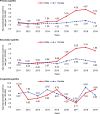Seasonality of syphilis in males through the 2011 to 2019 mandatory surveillance period: A cross-sectional study in South Korea
- PMID: 38115249
- PMCID: PMC10727654
- DOI: 10.1097/MD.0000000000036723
Seasonality of syphilis in males through the 2011 to 2019 mandatory surveillance period: A cross-sectional study in South Korea
Abstract
Although the effects of seasonality on syphilis have been discussed previously, no previous study has evaluated the seasonality of syphilis incidence by sex and age group. We examined the seasonality of syphilis incidence by sex and age group in Korea from 2011 to 2019. The incidence of syphilis was calculated on the basis of Korea Diseases Control and Prevention Agency data, and an autoregressive integrated moving average (ARIMA) model and seasonal and trend decomposition using Loess were used to analyze the seasonality of the incidence in relation to epidemiological factors. The annual age-standardized incidence rates of primary, secondary, and congenital syphilis were 21.1, 8.8, and 64.0 cases/million persons, respectively, from 2011 to 2019. The highest incidence rates for primary and secondary syphilis were observed among those aged 20 to 29, 13 to 19, and 30 to 49 years, but not among the lower age groups. In analyses based on the ARIMA model, all univariate time series showed the highest goodness-of-fit results with ARIMA for primary syphilis (1,1,2), secondary syphilis (1,1,1), and congenital syphilis (0,1,2) (2,0,0) models. This study suggests that the incidence of secondary syphilis shows a summer seasonality for males and the highest incidence rate in the 20 to 29-year age group for both males and females in Korea. Public health action is needed to prevent an increase in syphilis incidence associated with sex, age group, and seasonal patterns.
Copyright © 2023 the Author(s). Published by Wolters Kluwer Health, Inc.
Conflict of interest statement
The authors have no funding and conflicts of interest to disclose.
Figures





Similar articles
-
Time Series Modelling of Syphilis Incidence in China from 2005 to 2012.PLoS One. 2016 Feb 22;11(2):e0149401. doi: 10.1371/journal.pone.0149401. eCollection 2016. PLoS One. 2016. PMID: 26901682 Free PMC article.
-
Epidemiological behavior and current forecast of syphilis in Mexico: increase in male population.Public Health. 2020 Aug;185:386-393. doi: 10.1016/j.puhe.2020.05.057. Epub 2020 Aug 3. Public Health. 2020. PMID: 32758762
-
The Epidemiological Influence of Climatic Factors on Shigellosis Incidence Rates in Korea.Int J Environ Res Public Health. 2018 Oct 10;15(10):2209. doi: 10.3390/ijerph15102209. Int J Environ Res Public Health. 2018. PMID: 30309010 Free PMC article.
-
Changes in seasonality and sex ratio of scrub typhus: a case study of South Korea from 2003 to 2019 based on wavelet transform analysis.BMC Infect Dis. 2024 Sep 28;24(1):1066. doi: 10.1186/s12879-024-09858-0. BMC Infect Dis. 2024. PMID: 39342094 Free PMC article.
-
[SENTIERI - Epidemiological Study of Residents in National Priority Contaminated Sites. Sixth Report].Epidemiol Prev. 2023 Jan-Apr;47(1-2 Suppl 1):1-286. doi: 10.19191/EP23.1-2-S1.003. Epidemiol Prev. 2023. PMID: 36825373 Italian.
Cited by
-
Analysis of the trend of notifiable sexually transmitted infections in China between 2006-22.J Glob Health. 2025 Jun 27;15:04175. doi: 10.7189/jogh.15.04175. J Glob Health. 2025. PMID: 40570230 Free PMC article.
-
Analysis and prediction of the incidence temporal trends of echinococcosis in China from 2010 to 2021.Sci Rep. 2025 Feb 21;15(1):6423. doi: 10.1038/s41598-025-90207-9. Sci Rep. 2025. PMID: 39984565 Free PMC article.
References
-
- Heymann DL, APHA, ed. Control of Communicable Diseases Manual: An Official Report of the American Public Health Association. Washington: The American Public Health Association Press; 2008.
-
- Ghanem KG, Ram S, Rice PA. The modern epidemic of syphilis. N Engl J Med. 2020;382:845–54. - PubMed
MeSH terms
Supplementary concepts
LinkOut - more resources
Full Text Sources
Medical

